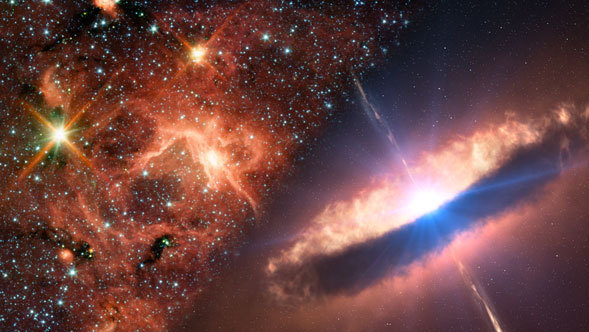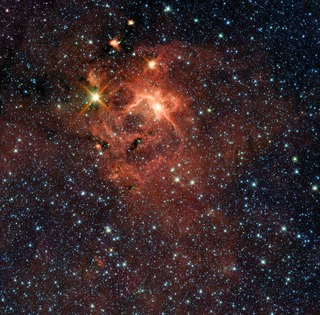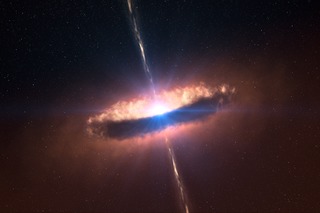
News Release • July 14th, 2010 • feature10-11 •
Astronomers caught their first glimpse of a dusty disk closely encircling a massive baby star, providing direct evidence that massive stars form in the same way as their smaller counterparts. The discovery was made thanks to a combination of data from the European Southern Observatory (ESO) and NASA's Spitzer Space Telescope.
"Astronomers have long been unclear about how the most massive stars form," said Stefan Kraus, a NASA Sagan Exoplanet Fellow and astronomer at the University of Michigan. "Because they tend to be at very large distances, and surrounded by dusty envelopes, it's very hard to separate and closely observe them."
To get a closer look, the team used ESO's Very Large Telescope Interferometer (VLTI) to focus on an object known by the cryptic name of IRAS 13481-6124. About twenty times the mass of our Sun, and five times its radius, the young central star, which is still surrounded by its baby blanket of dust and gas, is located in the constellation of Centaurus, about 10,000 light years away. "We were able to get a very sharp view into the innermost regions around this star by combining the light from separate telescopes," Kraus said, "basically mimicking the resolving power of a telescope with an incredible 85 meter-wide mirror."
Thanks to this unique capability, the team's observations detected a massive disk of dust and gas around the giant young star. "This is the first time that something like this has been observed," said Kraus, "The disk very much resembles what we see around young stars that are much smaller, except everything is scaled up and more massive".
The presence of a disk is strong evidence that even the largest stars in our galaxy are formed in the same way as smaller ones - born from the collapse of huge clouds of dust and gas, rather than from the merging of smaller stars, as previously suggested by some scientists. The confirmation of this came from the Spitzer Space Telescope data archive, which stores all of the 26.5 million images that have been taken during Spitzer's mission so far. "We looked at archival images of the star taken by Spitzer, and confirmed that the star is flinging disk material outward from its polar regions, just as we see with smaller stars and their dust disks," Kraus said.
The discovery also opens up the possibility that planets, even Earth-like ones, may be able to form around massive stars like IRAS 13481-6124, in the same way they formed around our sun when it was much younger. "In the future, we might be able to see gaps in this and other dust disks, created by orbiting planets, although it is unlikely that such bodies could survive for long," said Kraus. "A planet around such a massive star would be destroyed by the strong stellar winds and intense radiation as soon as the protective disk material is gone, which leaves little chance for the development of solar systems like our own.
Still, huge stars like IRAS 13481-6124 provide the building blocks for life to arise elsewhere in the Universe. "High-mass stars are where heavy elements necessary for life are created, so they are of major importance," Kraus said. "This discovery is a clearer picture than we've had before, and allows us to understand them better."
Spitzer previously detected dusty disks of planetary debris around more mature massive stars, further supporting the notion that planets may form even in these extreme environments. Read more about that research at /news/230
The Spitzer observations were made before it ran out of its liquid coolant in May 2009, officially beginning its warm mission.
For additional information and more images visit http://www.eso.org/public/news/eso1029/ .






